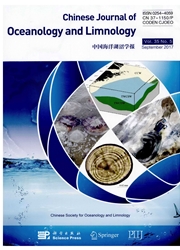

 中文摘要:
中文摘要:
我们在 2008 年 8 月吕宋岛海峡向西部署了二个 ADCP 绳索系统,并且在高频率测量了上面的海洋水流。二台风忽略了绳索在期间近似一个月观察时期。用 ADCP 观察,卫星风和热流动大小,和高分辨率的模型吸收产品,我们学习了上面的海洋的反应到台风。第一台风, Nuri,传递了超过一根绳索,导致冷却的强壮的 Ekman 分叉和重要表面。冷却表面水落后关于一天强迫的台风风并且持续了大约五天。第二台风, Sinlaku,向北方移动了吕宋岛海峡的东方,并且直接没在观察区域附近影响水流。Sinlaku 越过吕宋岛海峡增加了异常表面水运输交换,它调制了自台湾东面的菲律宾海流向日本的暖流的表面层水流。关键词 ADCP 观察 - 吕宋岛海峡 - 台风 - 表面电流由中国科学院的知识革新节目支持了(Nos. KZCX1-YW-12-01;KZCX2-YW-BR-04 ) ,中国的国家自然科学基础(Nos. 40876007, 40806006 ) ,并且中国(863 节目)( 号码 2008AA09A402 ) 的国家高技术研究和发展节目
 英文摘要:
英文摘要:
We deployed two ADCP mooring systems west of the Luzon Strait in August 2008, and measured the upper ocean currents at high frequency. Two typhoons passed over the moorings during approximately one-month observation period. Using ADCP observations, satellite wind and heat flux measurements, and high-resolution model assimilation products, we studied the response of the upper ocean to typhoons. The first typhoon, Nuri, passed over one of the moorings, resulting in strong Ekman divergence and significant surface cooling. The cooling of surface water lagged the typhoon wind forcing about one day and lasted about five days. The second typhoon, Sinlaku, moved northward east of the Luzon Strait, and did not directly impact currents near the observation regions. Sinlaku increased anomalous surface water transport exchange across the Luzon Strait, which modulated the surface layer current of the Kuroshio.
 同期刊论文项目
同期刊论文项目
 同项目期刊论文
同项目期刊论文
 期刊信息
期刊信息
